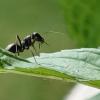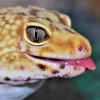Location of Collection: Collected on a college campus in Pikeville, KY. This city is nested in the Appalachian Mountain Range which spans several states. This particular area is within 30 miles of three different state borders (Virginia, West Virginia, and Tennessee) with plenty of out-of-state traffic.
Habitat: Border of disturbed habitat (campus, the city, etc.) and deciduous forest with a mixing of pine trees.
Special Notes: I found this queen walking on a brick walk on some snow that was melting from the sun. Temp was still low around 34 F, the snow had fallen the night before. There had not been any nuptial flights that I have been aware of in the last three days and this is not the season for it here anyways since its winter and this is definitely not Prenolepis imparis. Did not see a nest or detached wings anywhere nearby and no active ant colonies in the area that I've seen. It may be that the snow melt flooded her out of what was her nest for diapause or she hitched a ride with somebody coming for another state and fell off into the snow.
Date of Collection: Saturday 1/12/19, 12:30 PM
Length: 8 mm (from tip of gaster to tip of mandibles closed)
Number of Antennal Segments: 12
Description: Legs and underside and bands (lighter portions) amber in coloration, while rest of body is dark brown. She has little hairs all over and she is very shiny as well.
Although the photos may seem somewhat dark, they are accurate with coloration.
Pictures: https://imgur.com/a/jmGOl4d
Thank you for you time. Right now I am keeping her in my fridge in a tiny tupperware with a bit of water and a napkin for her to hide in so that she doesn't experience too much of a temperature shock. I'm getting some test tubes today, so if anyone has any ideas on what she is, if the species is parasitic, semi-claustral,or fully claustral, I would greatly appreciate it so that I can take better care of her.
Edited by DJoseph98, January 17 2019 - 7:22 AM.


















